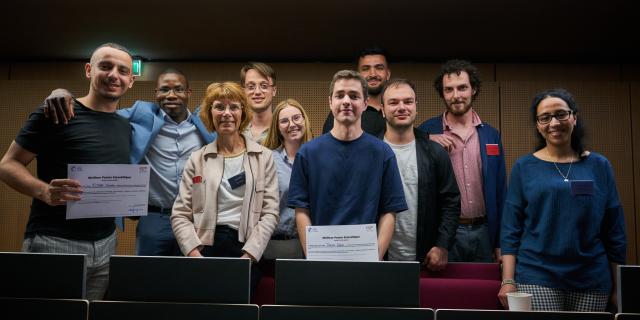
Thesis and internship topics
THESIS TOPICS PROPOSED AS PART OF THE DIGITAL TWINS OF CONSTRUCTION AND INFRASTRUCTURE IN THEIR ENVIRONMENT RESEARCH CHAIR
THESIS TOPICS
🟢 Study of Digital Twins in the construction of an Infrastructure project
ESTP has launched a “Digital twins of construction and infrastructure in their environment” Chair, in collaboration with Bouygues Construction, Egis, SNCF Réseau, Schneider Electric, BRGM and Arts et Métiers. The aim is to support a holistic and shared vision of the topic - from knowledge to concrete applications - that promotes the sharing of industrial and scientific production. The desire is to place the concept of digital twins at the service of digital transition in the construction sector, and to support digital continuity, the permanence of data and their interoperability.
The topic of this thesis is centred on the Digital Twin(s) of a construction site, and more particularly an infrastructure construction site. It aims to develop one (or several) Digital Twin(s) as from the construction site preparation phase, and throughout the implementation of the site until delivery and/or commissioning.
🟢 Diagnosing and assessing a Digital Twin for automatic alert management, case study: railway network
Digital twins (DT) are components of the shared data environment which apply to all owners, designers, builders and users of the work. Much like other data storage and dissemination methods (databases, geographic information systems, etc.), digital twins under creation must be updated in a simple and efficient manner to ensure they remain accurate over time.
Today, the many digital twins in existence are fed by continuous (IOT) or punctual data sources (3D laser scanner, cameras) which can be considered as accurate representations of the site. This thesis therefore aims to assess discrepancies between these data sources and the contents of existing digital twins. Any such discrepancies bear witness to the change to the physical system, rendering the digital clone partially obsolete. These discrepancies are fed back by a warning system (with the suggestion of updating the clone).Reflections will be conducted on the process for updating the system.The case study will be a portion of railway between Lyon and Saint-Etienne. This line is equipped with various IoT sensors, and is regularly travelled by line surveillance trains equipped with 3D laser scanners.
🟢 Multi-physical multi-scale seismic digital twin in complex geological environments for industrial risks
The Chair provides a particularly rich working environment, comprised of many academic and industry experts. It aims to recruit a number of doctoral students to work on additional issues and contribute towards overcoming various scientific and technical obstacles in the field.
This thesis will investigate the four fundamental seismic risk assessment processes, i.e.: i) the break in seismic source with imposed kinematics driven by the eikonal equation, ii) the propagation of waves in multi-scale geological structures driven by the equations of motion, iii) the complex (potentially non-linear) behaviour of near-surface soils, and iv) the works’ seismic response. Simulations will be conducted on regional and national HPC3 clusters using the EFISPEC3D4 open-source community code (De Martin et al., 2021). Semi-automated workflows and Machine Learning tools will be developed to automatically process the large volumes (potentially terabytes) of data generated by the seismic scenarios.
🟢 Digital Twins for territorial sustainability - optimising, securing and sustaining information through a holistic and multi-scale approach.
Case study: Nice Métropole, Marseille Tramway
At territorial scale, the aim is not to design a unique and integral digital twin but rather to bring together several digital twins designed in compliance with the standards and principles of open collaboration. The Geographical Information Systems used by local authorities, motorway, urban network (utilities), building, parking, station and airport blueprints are interfaced. The territorial digital twin thus built is implemented for situations meeting the requirements of a smart and sustainable city, such as:
• Optimization of travel flows and operational management within a territory,
• Simulation of the impact of structural changes and changes in user behaviour,
• Energy performance at community- or city-level, from the perspective of diverse energies and uses: energy pooling (energy where and when it is needed)
• Optimization of a territory’s capacities in terms of resilience in case of deterioration to infrastructures or buildings, seismic activity or extreme climate episodes,
• Reduction of greenhouse gas emissions,
• Provision of citizens with information to ensure their participation in climate change management.
THESES IN PROGRESS (AS AT 21/12/2021)
[1] “Forecast capacities of discrete modelling applied to complex geotechnical structures”, prepared by Bilal EL-TFAILY (2A), for defence in October 2023. Thesis for the Engineering Doctoral School - Materials, Mechanics, Environment, Energy, Processes, Production (I-MEP2), directed by L. SIBILLE (UGA), co-supervised by L. SIBILLE, A. BENNABI and R. ABOUL HOSN, co-financed by INP and the ESTP Foundation.
[2] “Impacts of heterogeneities in granular materials by suffusion in soils constituting hydraulic works” prepared by Jean-Bruce GBOGA (3A), for defence in October-November 2021. Thesis under the co-tutelage of the Université Paris-Est Science, Engineering and Environment Doctoral School and of the INP HB, co-directed by J-C. DUPLA (UPE) and A. KONIN (INP HB), supervised by A. BENNABI, co-financed by INP HB and C2D.
[3] “Study of ground collapse phenomena around bridge piers founded on cohesive soils and contribution towards adapting constructive solutions”, prepared by Jana ZAIDAN (2A-3A), for defence in September 2022. Thesis of the Université de Normandie Doctoral School, directed by Université Le Havre, co-directed by A. BANAMAR and A. BENNABI, co-financed by the Normandie region and the ESTP Foundation.
[4] “Surface erosion in soils: local law and influence of soil properties and of run-off on hydraulic structures’ resistance to erosion”, prepared by Shadi YOUSSEF -3A), for defence in September 2022. Thesis of the Institut National de Recherche en Sciences et Technologie pour l’Environnement et l’Agriculture (IRSTEA), directed by P. PHILIPPE (IRSTEA), co-supervised by N. BENAHMED, P. PHILIPPE (IRSTEA), A. BENNABI and A. POUPARDIN, co-financed by IRSTEA and the ESTP Foundation.
[5] “Modelling and command of a Parallel Multicellular Converter”, prepared by Dyhia KAIS (3A), for defence in 2022. Thesis of the Quartz Doctoral School, directed by H. DENOUN (Université Mouloud Mammeri de Tizi-Ouzou), supervised by B. AMGHAR, financed by Université Mouloud Mammeri de Tizi-Ouzou (student accommodation).
[6] “Composite materials for elimination of polluting gases” prepared by Matthieu MESNAGE (2A), for defence in October 2023. Thesis of the “Energy, Materials, Earth and Universe Sciences” Doctoral School, EMSTU, directed by J. JEONG, supervised by J. JEONG, co-financed by CNRS (Région Centre) and the ESTP Foundation.
[7] “Response and damage to pipework under seismic pressure and improvement of engineering methods” prepared by Axel MERIC (1A), for defence in May 2024. Thesis of the Ecole Nationale Supérieure de Techniques Avancées (ENSTA ParisTech), co-directed by J-F. SEMBLAT (IMSIA, ENSTA ParisTech) and D. BOUSSA (CNRS, LMA), supervised by P. LABBE, financed by GDS (Cifre).
[8] “Analysis of solutions to limit the external erosion of rear banks of earthen dykes subject to wave swell”, prepared by Clément LUTRINGER (2A), for defence in October 2023. Thesis of the Université Paris-Est Science, Engineering and Environment (SIE) Doctoral School, directed by J. JEONG, supervised by A. POUPARDIN, co-financed by the ESTP Foundation and Les Salins du Midi.
[9] “Re-use of plant fibres in cement materials. Application to high performance concrete and subfloor formulations”, prepared by Sergio PONS RIBERA (3A), for defence in October 2022. Thesis of the Université Paris-Est Science, Engineering and Environment (SIE) Doctoral School, directed by R. HAMZAOUI, co-supervised by B. VASSEUR and J. COLIN, co-financed by ADEME, Région Grand-Est and the ERDF.
[10] “Study of hydraulicity regeneration mechanisms in cement as part of a circular economy approach”, prepared by Abdellatif ABIDAR (1A), for defence in June 2024. Thesis of the Université Paris-Est Science, Engineering and Environment (SIE) Doctoral School, directed by R. HAMZAOUI, co-supervised by S. MANSOUTRE (EFB) and O. BOUCHENAFA, co-financed by the ESTP Foundation, CIMENTS CALCIA, LAFARGE France and GROUPE VICAT.
[11] “CO2 capture in recycled concrete aggregates”, prepared by Mounia BOUGHALEB (1A), for defence in October 2024. Thesis of the Université Paris-Est Science, Engineering and Environment (SIE) Doctoral School, directed by J. JEONG, co-supervised by J. COLIN and A. POUPARDIN, co-financed by the ESTP Foundation and the ANR (FastCarb project).
[12] “ Formulation, workability, mechanics, and durability of low-carbon cements”, prepared by Houryie HARMOUCHE (1A), for defence in October 2024. Thesis of the Université Paris-Est Science, Engineering and Environment (SIE) Doctoral School, directed by O. OMIKRINE-METALSSI (UGE), co-supervised by C. FLORENCE and O. BOUCHENAFA, co-financed by the ESTP Foundation and UGE.
[13] “Structuring of digital twin data to reconcile real and simulated models - Case Study: Energy Models for buildings”, Student Zhiyu ZHENG (1A). Thesis as part of the Digital Twin chair, directed by F. ABABSA (ENSAM), supervised by E. FARAZDAGHI, financed by the DT Chair.
[14] “SOILTRACKING: Wireless sensor networks to track polluted soils”. Student Edern VIANNAY (ESTP) (1A). Directed by SNOUSSI (UTT), supervised by B. MECHERI, financed by AEXDO.
[15] “Excavated earth for facades”, Student Arthur LAM (ESTP). Directed by R. HAMZAOUI, supervised by A. KINDINIS, financed by SAINT-GOBAIN.
💡 ESTP Paris has four Training-Innovation-Research chairs which fall under the topic of constructability | Learn more
